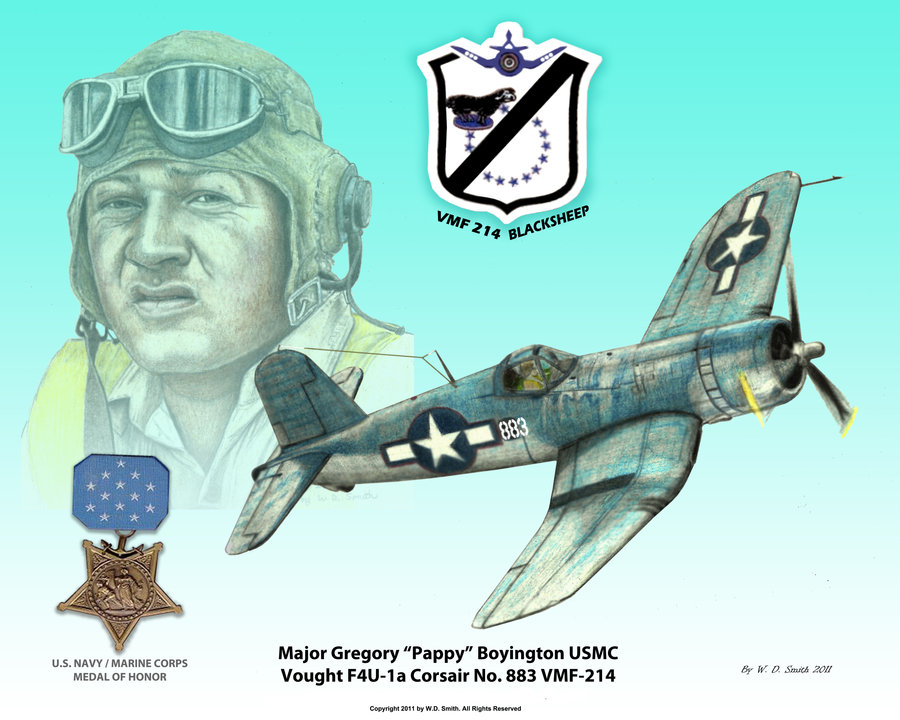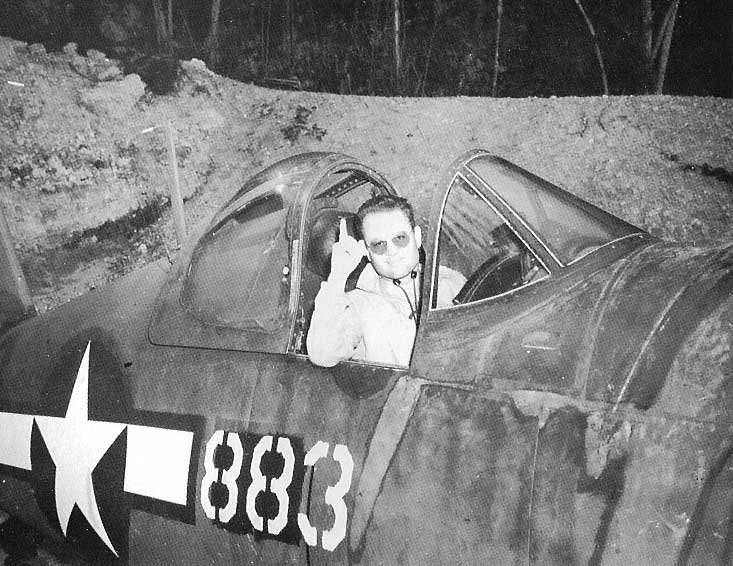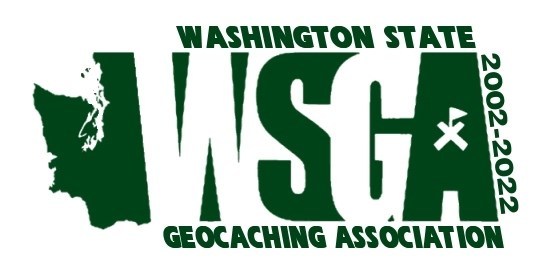Military Aviation History - Pappy Boyington Traditional Geocache
Military Aviation History - Pappy Boyington
-
Difficulty:
-

-
Terrain:
-

Size:  (micro)
(micro)
Please note Use of geocaching.com services is subject to the terms and conditions
in our disclaimer.
Military Aviation History
Pappy Boyington
Gregory "Pappy" Boyington was born on December 4, 1912 in Coeur d'Alene. He grew up in St. Maries, Idaho and in Tacoma, Washington.
He took his first flight when he was six years old, with Clyde Pangborn, who later flew the Pacific non-stop. In 1930, Boyington entered the University of Washington, where he joined the Reserve Officers Training Corps (ROTC). He was a member of the college wrestling and swimming teams, and at one time held the Pacific Northwest Intercollegiate middleweight wrestling title. Boyington graduated in 1934 with a B.S. in aeronautical engineering. He spent his summers working in Idaho in a mining camp and logging camp and with the Coeur d'Alene Fire Protective Association in road construction and lookout work.
Boyington‘s military career began in college, as a member of the ROTC in which he became a cadet captain. He was commissioned a second lieutenant in the Coast Artillery Reserve in June 1934 and served two months of active duty with the 630th Coast Artillery at Fort Worden, Washington. On June 13, 1935, he enlisted and went on active duty in the Volunteer Marine Corps Reserve.
On February 18, 1936, Boyington accepted an appointment as an aviation cadet in the Marine Corps Reserve. He was assigned to the Naval Air Station, Pensacola, Florida, for flight training. He was designated a naval aviator on March 11, 1937, and then was transferred to Quantico, Virginia, for duty with Aircraft One, Fleet Marine Force. He was discharged from the Marine Corps Reserve on July 1, 1937 in order to accept a second lieutenant's commission in the regular Marine Corps the following day.
Boyington resigned his commission in the Marine Corps on August 26, 1941, to accept a position with the Central Aircraft Manufacturing Company (CAMCO). CAMCO was a civilian organization that contracted to staff a Special Air Unit to defend China and the Burma Road. The unit later became known as the American Volunteer Group (AVG), the famed “Flying Tigers” of China. During his months with the "Tigers", Boyington became a flight leader. He was frequently in trouble with the commander of that outfit, Claire Chennault. As a member of the AVG 1st Squadron, Boyington was officially credited with 3.5 Japanese aircraft destroyed in the air and on the ground, but AVG records suggest that one additional "kill" may have been due to him. (He afterward claimed six victories as a Tiger, but there is no substantiation for that figure.)
In the spring of 1942, he broke his contract with the AVG and returned to the United States, where he was eventually re-instated in the Marine Corps. Boyington wrangled a major's commission in the Marines, which were in great need of experienced combat pilots. He was assigned to Marine Aircraft Group 11 of the 1st Marine Aircraft Wing, where he became Executive Officer of VMF-121 operating from Guadalcanal. While assigned to VMF-121, Boyington did not shoot down any enemy planes. Later, he became the Commanding Officer (CO) of Marine Fighter Squadron 214, better known by its nickname, the "Black Sheep Squadron." It was here as the CO that Boyington earned the nickname "Gramps" because, at age 31, he was a decade older than most of his men. (Nicknames of this type are common within the armed forces, especially because the commanding officer of a unit is often referred to as "the old man".) It later became "Pappy" in a variation on "The Whiffenpoof Song" whose new lyrics had been written by Paul "Moon" Mullen, one of his pilots and this version was picked up by war correspondents.

Boyington is best known for his exploits flying the Vought F4U Corsair in VMF-214. During periods of intense activity in the Russell Islands-New Georgia and Bougainville-New Britain-New Ireland areas, Boyington added to his total almost daily. During his squadron's first tour of combat duty, the major shot down 14 enemy fighter planes in 32 days. By December 27, 1943, his record had climbed to 25. A typical daring feat was his attack on Kahili airdrome at the southern tip of Bougainville on October 17, 1943. He and 24 fighters circled the field where 60 hostile aircraft were based, goading the enemy into sending up a large force. In the fierce battle that followed, 20 enemy aircraft were shot down while the Black Sheep returned to their base without loss. Boyington’s squadron, flying from the island of Vella Lavella, offered to down a Japanese Zero for every baseball cap sent to them by major league players in the World Series. They received 20 caps and shot down many more enemy aircraft.
He tied the American record of 26 planes on January 3, 1944 over Rabaul, but was shot down himself later the same day. The mission had sent 48 American fighters, including one division of four planes from the Black Sheep Squadron, from Bougainville for a fighter sweep over Rabaul. Boyington was the tactical commander of the flight and arrived over the target at eight o'clock in the morning. In the ensuing action, the major was seen to shoot down his 26th plane. He then became mixed in the general melee of diving, swooping planes and was not seen or heard from again during the battle, nor did he return with his squadron. Boyington's wingman Captain George Ashmun was killed in action. In later years, Masajiro "Mike" Kawato claimed to have been the pilot who shot down Boyington's plane. He described the combat in two books and numerous public appearances (often with Boyington), but this claim was eventually "disproven," though Kawato held to his story until his death. It is a matter of record that Kawato was present during the action in which Boyington was downed, as one of 70 Japanese fighters which engaged approximately 30 American fighters. Following a determined but futile search, Boyington was declared missing in action. He had been picked up by a Japanese submarine and became a prisoner of war. (The submarine was sunk 13 days after picking him up.) According to Boyington's autobiography, he was never accorded official P.O.W. status by the Japanese and his captivity was not reported to the Red Cross. He spent the rest of the war, some 20 months, in Japanese prison camps. The Marines listed him as missing in action, and many thought he died in the crash. He was awarded a Medal of Honor by President Roosevelt and during that time he was selected for temporary promotion to the rank of Lieutenant Colonel.

During mid-August 1945, after the atomic bombs and the Japanese capitulation, Boyington was liberated from Japanese custody at Omori Prison Camp on August 29th. Boyington returned to the United States at Naval Air Station Alameda on September 12, 1945 and where he was met by 21 former squadron members from VMF-214. Prior to his arrival, on September 6th, he accepted his temporary Lieutenant Colonel's commission in the Marine Corps.
In 1958 Boyington wrote a best-selling book about his wartime experiences called "Baa Baa, Black Sheep." A television series by the same name, with Boyington as technical adviser, debuted in 1976 and lasted two seasons. He died on January 11, 1988, in Fresno, California at the age of 75 and was buried in Arlington National Cemetery.

To the north of ground zero you will see what was once known as the Coeur d'Alene Air Terminal. That name changed in September of 2007 when a group of local veterans convinced the Kootenai County Board of County Commissioners to rename it the Coeur d'Alene Airport / Pappy Boyington Field to honor LTC Gregory "Pappy" Boyington, the World War II Medal of Honor recipient who just happened to have been born in Coeur d'Alene.
| If you are a Geocacher in eastern Washington or northern Idaho, please join the Inland Empire Chapter of the Washington State Geocaching Association. This is a great way to get the most out of Geocaching in our region. Simply go to the WSGA Web Page for details! |
 |
Additional Hints
(Decrypt)
Terra